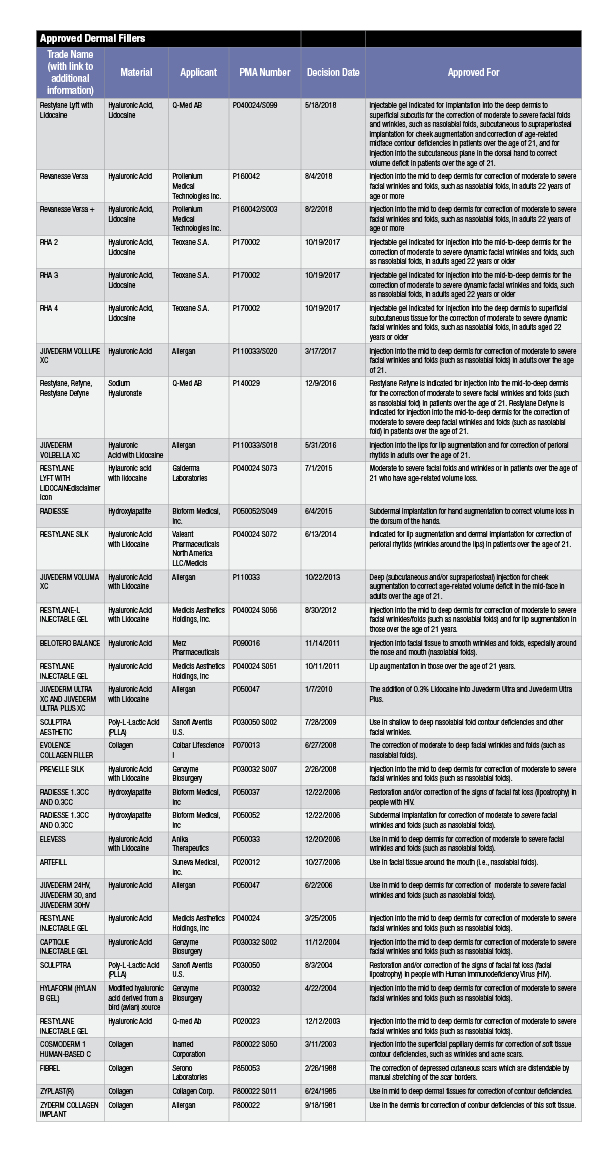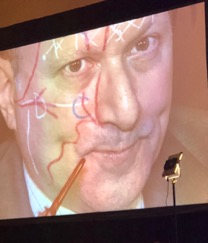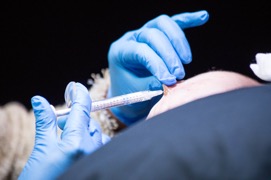What’s in Your Toolbox
There are over 20 dermal fillers available in the U.S. and many more are on the way. In Europe, Asia, and the Middle East there are currently hundreds of dermal fillers available.
While there are only a handful of FDA- approved dermal fillers manufacturers in the U.S., each company has several product lines. These fillers are usually for superficial, medium and deep injections. Recently, these manufacturers have been adding fillers that are designed to treat specific areas of the face.
The aesthetic toolbox has a lot of exciting tools. You can use dermal fillers on both males and females, patients of all skin types and ethnicities, and various anatomic locations from the chin, earlobes, temples, lips and check bones allowing you to safely and effectively treat your patients. It is an exciting time in cosmetic dermatology!

Source: U.S. Food and Drug Administration – Dermal Fillers Approved by the Center for Devices and Radiological Health https://www.fda.gov/MedicalDevices/ProductsandMedicalProcedures/CosmeticDevices/ucm619846.htm. Retrieved 12.28.18.
Make sure to visit the FDA website for a comprehensive list of all approved dermal fillers and their safety and effectiveness data.
What You Need to Know About Dermal Fillers
First and foremost, their properties. The rheolgical properties vary based on the dermal product’s viscosity, elasticity, and cohesivity. Viscosity and elasticity are measured by the G prime (G’). Dermal fillers with high G prime are firmer and tend to keep their shape. This is important in facial rejuvenation in that these products have more lifting capacity.
In contrast, those with low G prime are thinner, more fluid, and have easier spread. These are best for areas of fine lines such us around the mouth or in the “tech neck” or “necklace” lines on the neck.

A dermal filler that has high cohesivity will stick together without spreading out, a filler with low cohesivity will form to the bone more easily.
It is important to understand the properties of the dermal filler you will use but more importantly you have to understand the patient, their goals, and the quality of their skin. If you want to lift the cheeks of an older female patient with thin skin it is very different approach than a male patient with more sebaceous thick skin and facial hair. It is not just the filler, but also the understanding of the products and more importantly your patients.
 The Art and Science of Injecting
The Art and Science of Injecting
The science of being a great injector is first and foremost knowing the anatomy cold! Knowing the important nerves, arteries, and veins is absolutely critical. You want to avoid at all costs injecting into them and causing harm to your patients.
The art is more about the injector than the actual material being injected. With that said, you can cause harm. Using the wrong filler in a particular location can cause an adverse event for the patient. Swelling, nodules, lumps, and the Tyndall effect, making the skin look bluish when filler is placed too superficially.
 If you use a low G prime filler for lifting the chin, cheeks, or jawline, it will not cause harm to the patient but you would have wasted their time and money as it will do nothing to achieve their desired cosmetic result. Using a high G prime filler like calcium hydroxyl appetite into lips or under the eyes can cause very lumpy nodules that cannot be dissolved.
If you use a low G prime filler for lifting the chin, cheeks, or jawline, it will not cause harm to the patient but you would have wasted their time and money as it will do nothing to achieve their desired cosmetic result. Using a high G prime filler like calcium hydroxyl appetite into lips or under the eyes can cause very lumpy nodules that cannot be dissolved.
The art of injection involves knowing how the syringe feels in your hand, the resistance when injecting and how the filler will flow. This is critical so you do not over correct an area and leave the patient with nodules or a non-desirable outcome.
 An experienced dermatologist will know the right volume, the technique, the speed and which filler to use. Knowing when and where to use a needle versus canula and blended fillers is part of the art.
An experienced dermatologist will know the right volume, the technique, the speed and which filler to use. Knowing when and where to use a needle versus canula and blended fillers is part of the art.
For newer injectors, my advice is to start out by using one baseline filler in an area. Once you feel more comfortable and have gained more confidence, you can take on more.
I also recommend using one product line during a patient visit in the beginning for safety reasons. If you do have any adverse reactions, you will know the type of filler you used and in which area. This information will allow you to call the manufacturer and address the issue.
It is an exciting time with so many fillers available for your practice. It is important to know the safety and risk profile for the products you will use to assure the best patient outcomes.
If you are interested in learning more about dermal fillers and gain hands-on experience with injectables, make sure to register for the upcoming ODAC conference (January 18th-21st) in Orlando where Dr. Houshmand will lead the following sessions:
The ABC of Choosing & Using Injectables
Before You Inject…Assess! – Facial Assessment Basics
Injectables Live Demos: Upper, Lower, and Mid-Face
Did you enjoy this post? Find other articles on Aesthetic Derm Topics by clicking here.

